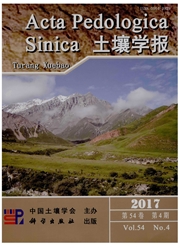

 中文摘要:
中文摘要:
多尺度空间自相关性是土壤动物空间异质性和空间共存格局研究的重要基础。在中国科学院三江平原沼泽湿地生态实验站的农田内,以5 m为步长设置一个50 m×50 m的样地,结合全局Moran’s I 和局部Moran’s I指数,研究地表、地下和地表—地下土壤螨群落多尺度空间自相关性特征。结果表明,地表和地下土壤螨群落的物种数量和平均密度均有显著差异。全局空间自相关性结果表明,除了地表螨群落,地下螨群落平均密度在8月(35~40 m)和10月(5~30 m)、地表—地下螨群落平均密度在8月(5~10 m和35~45 m)和10月(5~35 m)均有显著的多尺度全局空间自相关性,土壤螨群落中数量较多的优势和常见类群易形成明显的多尺度全局空间自相关性。局部空间自相关性结果表明,地表、地下和地表—地下螨群落及所有螨类的平均密度均存在显著的局部空间自相关性,形成“斑块”和“孔隙”并存的水平分布格局。本研究表明,多尺度全局空间自相关性是地下和地表—地下土壤螨群落的重要特征,群落和物种的平均密度均在局部地区形成“斑块”和“孔隙”并存的的水平分布格局。
 英文摘要:
英文摘要:
Multi-scale autocorrelation is an important basis of the study on spatial heterogeneity and spatial co-occurrence patterns of soil animals. A sampling field, 50 m × 50 m, was set up in farmland of the Sanjiang Plain Marsh and Wetland Ecological Experiment Station. The farmland had a history of more than 30 years of cultivation. The sampling field was divided into 100 subsamples and intensive samplings were done at the nodes of a 10 × 10 regular grid with 5 m inter-sample distances. Overall Moran’s I and Local Moran’s I were used to determine multi-scale spatial autocorrelations for mean density of the aboveground, belowground and above-belowground mite communities. Results show that the number of species and mean density of mite communities varied sharply between aboveground and belowground ones. Overall spatial autocorrelation analysis revealed that the mean density of the belowground mite communities showed significantly spatial autocorrelations was 35~40 m in August and 5~30 m in October, and of the above-belowground mite communities was 5~10 m, 35~45 m and 5~35 m, respectively, showing obvious multi-scale spatial autocorrelations between them and obvious multi-scale spatial autocorrelations also existed between dominant mite groups that were often large in number and commonly observed miter groups in the soil mite communities. Local spatial autocorrelation analysis indicates that significant local autocorrelations existed between the whole soil mite community and mite communities above the ground, under the ground and above-belowground in mean density, thus forming a horizontal distribution pattern with coexisting “patches” and “gaps”. All the above listed findings demonstrate that multi-scale spatial autocorrelation is an important feature of the belowground and above-belowground mite communities in farmland of the Sanjiang Plain, with mean densities of the mide communities and species forming a horizontal pattern with coexisting “patches” and “gaps”.
 同期刊论文项目
同期刊论文项目
 同项目期刊论文
同项目期刊论文
 New record of the genus Caputanurina Lee, 1983 (Collembola : Neanuridae) from China, with descriptio
New record of the genus Caputanurina Lee, 1983 (Collembola : Neanuridae) from China, with descriptio A new species of Ceratophysella Borner, 1932, (Collembola : Hypogastruridae), and description of Chi
A new species of Ceratophysella Borner, 1932, (Collembola : Hypogastruridae), and description of Chi New records of the genera Acerentulus and Brasilidia (Protura : Acerentomidae) from China, with desc
New records of the genera Acerentulus and Brasilidia (Protura : Acerentomidae) from China, with desc New Zealand species of Oribotritia (Acari: Oribatida: Oribotritiidae): descriptions of two new speci
New Zealand species of Oribotritia (Acari: Oribatida: Oribotritiidae): descriptions of two new speci Atropacarus (Atropacarus) niedbalai sp. nov., an extreme case of neotrichy in oribatid mites (Acari:
Atropacarus (Atropacarus) niedbalai sp. nov., an extreme case of neotrichy in oribatid mites (Acari: Microtritia species (Acari, Oribatida, Euphthiracaridae) from China, with description of a new speci
Microtritia species (Acari, Oribatida, Euphthiracaridae) from China, with description of a new speci Oribatid mites from Wanda Mountains in China, with description of a new species of the genus Pilogal
Oribatid mites from Wanda Mountains in China, with description of a new species of the genus Pilogal Two new peculiar ptyctimous mites (Acari: Oribatida: Phthiracaridae) from the Australian region, wit
Two new peculiar ptyctimous mites (Acari: Oribatida: Phthiracaridae) from the Australian region, wit Descriptions of two new species of Austrophthiracarus Balogh et Mahunka, a newly recorded genus of p
Descriptions of two new species of Austrophthiracarus Balogh et Mahunka, a newly recorded genus of p Three new species of the genus Austrophthiracarus from New Zealand (Acari: Oribatida: Phthiracaridae
Three new species of the genus Austrophthiracarus from New Zealand (Acari: Oribatida: Phthiracaridae Co-occurrence Patterns of Above-ground and Below-ground Mite Communities in Farmland of Sanjiang Pla
Co-occurrence Patterns of Above-ground and Below-ground Mite Communities in Farmland of Sanjiang Pla 期刊信息
期刊信息
